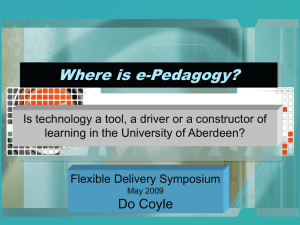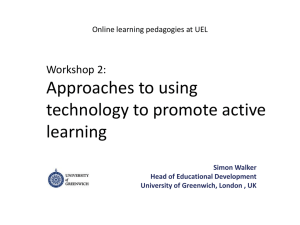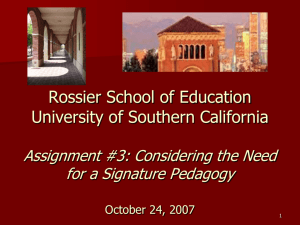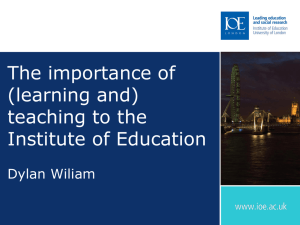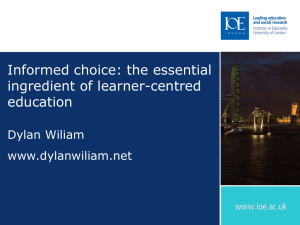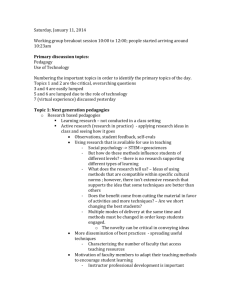Studio practice and first in family students
advertisement
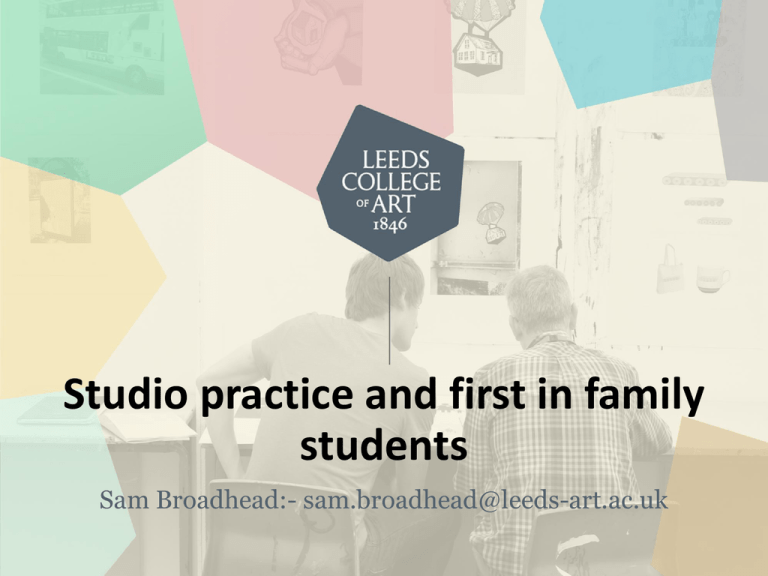
Studio practice and first in family students Sam Broadhead:- sam.broadhead@leeds-art.ac.uk First in the family within art and design higher education • We need to tackle widening participation in Higher Education • - But also widening participation within the subject area of art and design • We also need to critically reflect on the elitist cultures within a small specialist institution continue to be reproduced. • Context of first in the family in the art school • My research • Signature pedagogies • Student’s response to studio practice • Interventions • Reflective comments Low Participation Neighbourhoods • http://www.hefce.ac.uk/analysis/yp/gaps/ Expected Attainment is the rate of participation in comparison with their potential to progress; so attaining entry requirements but not participating in HE. http://www.hefce.ac.uk/analysis/yp/POLAR/Map,of,young,participation,areas/ Entry Tariff - Total Student and First in Family starting study at Leeds College of Art Entry Tariff - Total Student and First in Family All Entry Students First in Family 12/13 354.9 357.6 13/14 381.9 379.5 14/15 375.6 367.9 fif over last two years lower entry tariff in comparison with student cohort Tarif average has increased then fallen off over the 3 yr period - as has the student UG entry population as a whole Retention Summary - Total Student and First in Family at Leeds College of Art Retention Summary - Total Student and First in Family %'s All Students 12/13 13/14 14/15 Average ContQual Non_HE Transfer ContQual Non_HE Transfer 92.2 7.0 0.9 93.4 6.6 0.0 92.7 6.8 0.5 92.1 7.9 0.0 93.8 5.4 0.7 92.7 6.1 1.1 92.9 6.4 0.7 92.8 6.9 0.4 Trend StDev fif over last two years higher non continuation rate First in Family 0.7 0.7 Continuation fell off then improved over 3 yr period Classification Summary - Total Student and First in Family achieved by graduating students at Leeds College of Art Classification Summary - Total Student and First in Family %'s All Students First in Family Good Lower Good Lower 73.2 26.8 70.5 29.5 % of fif good degrees rises then falls off over 3 yr period. Trend is more accentuated than with total cohort. 12/13 13/14 14/15 Average 75.5 24.5 79.0 21.0 73.3 26.7 68.1 31.9 74.0 26.0 72.1 27.9 Trend StDev fif for two of the years of the last three years shows a lower % of good degrees 1.1 4.7 All these trends link up with tariff band. Methodology: Longitudinal study from 2011 to 2014 All participants have previously achieved an Access to HE Diploma course in art and design. 9 students opted to take part, 3 men and 6 women 1 dropped out, 5 continued to study at the art school 3 when to a local HEI. Participants are given other names to protect identities Stories were collected at various points during their degrees through narrative inquiry (Clandinin and Connelly, 2004) Signature pedagogies • teaching and learning differs from discipline to discipline has been identified through notions of ‘academic tribes and territories‘ (Becher 1989, Becher and Parry 2005) • different cultures have evolved for individual disciplines • distinct boundaries between the languages and social practices which each discipline espouses. Signature pedagogies • not only are there differences in academic content and language • but in the ways that students learn the content of their disciplines • particularly where these are related to professions (Shulman 2005b). Signature pedagogies of art and design Visible pedagogies Invisible pedagogies Invisible Pedagogy – one means of reproducing class bias It is as if this pedagogic practice creates a space in which the acquirer can create his/her text under conditions of apparently minimum external constraint and in a context and social relationship which appears highly supportive of the ‘spontaneous’ text the acquirer offers. (Daniels, 1989; Bernstein, 2003: 201) Studio space – how to be creative? Invisible Pedagogy An invisible pedagogy…is likely to create a pedagogic code intrinsically more difficult, initially at least, for disadvantaged social groups (from the perspective of formal education) to read and to control. (Bernstein, 2003: 207) Invisible Pedagogy – communication skills Middle class families could afford the resources needed to facilitate invisible pedagogy at home where acquirers were controlled by sophisticated levels of communication (Bernstein 2003, p.210). As a result people from middle class families were more likely to thrive when exposed to an invisible pedagogy in an official site of learning. This method of education privileged those middle class students whose employment had a direct relation to the ‘field of symbolic control and who work in specialized agencies of symbolic control usually located in the public sector. . . .’ (Bernstein 2003 p.204). Invisible Pedagogy – surveillance • The acquirer was active in their own acquisition any intrusion from the transmitter was seen as potentially dangerous as it subverted ‘natural’ development of learning and discovery by imposing social rules (Bernstein, 2003 p.200). • The space in which invisible pedagogies took place enabled the surveillance of students where their learning practices were open to public scrutiny. • Tutors view the student as a text which can be ‘read’ • This meant there was a potential for tutors to misread the students. • Implicit control through communication • Implicit control through surveillance • Significance of time and space Miscommunication and frustration She was saying stuff, I was saying, ‘you’ll have to explain what you mean by that, you’re going to have to explain to me exactly what…’ I could see that she was getting frustrated; I was getting frustrated. I kind of just thought that’s it! I don’t want to hear any more. I don’t to do any more feedbacks. And the last one we had to do, fortunately, I wasn’t there so she couldn’t give me any feedback. (Eliza, November 2011) Implicit , indirect control of learning process It seemed like the tutors had taken a backward step. You were left kind of on your own. That much I didn’t mind but it caused a few problems in the beginning for me, particularly, because it felt like your hand was being held and then suddenly it’s been taken away. (Snake, June 2012) Not aware of the ‘rules of the game’ ‘Blowing in the wind’ - I feel a bit ‘blowing’ - I’m not sure what I’m supposed to be doing; if I’m doing enough or doing it the right way. They keep telling me there is no right way or wrong way. I don’t like things being undefined. (Joe, June 2012) Not understanding the significance of space and time [O]riginally I didn’t have a space I was the last one left. I had to give my space up because this lass wanted to be with a friend so I gave her my space and then I was just the last one to have a space. (Jo, Nov 2011) Interventions – increase self-worth by Widening Participation and Progression team Children’s art group – immersion into HEI/art college as a place of belonging becoming part of the community Interview practice – rehearsal of modes of communication Summer schools – taster of higher education Mature learners group – mentoring and buddying group Interventions – increase self-worth by Widening Participation team Activities are targeted trying to reach through working with Polar 3 schools (quintiles 1-2 lowest participation in HE) first in family people. Low participation neighbourhoods, LPN free school meals, English as an additional language EAL These activities are about preparing students from different backgrounds rather than changing the practices of art and design HE. Interventions - Typography Interventions - Ceramics Interventions – Drawing Interventions - Animation Interventions – Summer School Some concluding reflections Interventions are introducing students from a wide range of backgrounds to the signature pedagogies of art and design, but… Is there ‘buy in’ from the academic staff generally, or are these marginalised within the Widening Participation and Progression team ? Students need to fit into the culture of the art school rather than the art school adapting and responding to other ways of being. Do these interventions reproduce the deficit model associated with under-represented groups? • • • • • • • • • • • Becher, T. (1989) Academic tribes and territories: intellectual enquiry and the culture of disciplines. Milton Keynes SRHE/Open University Press. Becher, T. & Parry, S. (2005) The endurance of the disciplines. In Bleikle, I., & Henkel, M. (Eds) Governing Knowledge: a study of continuity and change in higher education. Dordrecht, Springer pp 133-143. Bernstein, B. (1958) 'Sociological determinants of perception: An enquiry into sub-cultural differences'. The British Journal of Sociology. 9 (2), 159-174. — (1975) 'Class and pedagogies: visible and invisible'. In Halsey, A., Brown, P., Lauder, H., and Stuart Wells, A. (eds) (1997) Education: Culture, economy and society. Oxford: Oxford University Press , 59-79. — (2003) Class, Codes and Control: Theoretical studies towards a sociology of language. London: Routledge. Daniels, H. (1989) ‘Visual displays as tacit relays of the structure of pedagogic practice’, BritishJournal of the Sociology of Education, 10 (2), 123–40. Schön, D. A. (1985). The Design Studio: An Exploration of Its Traditions and Potentials. London: RIBA Publications Ltd. Shreeve, A. (2011) 'The way we were? Signature pedagogies under threat'. In: Researching design education, 1st International Symposium, CUMULUS // DRS for Design Education Researchers. Proceedings of a conference held at the Paris Chamber of Commerce and Industry, 18 May 2011. Paris, France: CUMULUS ASSOCIATION and DRS, 112– 125. Shulman, L. S. (2005a). Pedagogies of uncertainty. Liberal Education. 91, 18-25. Shulman, L. S. (2005b). Signature pedagogies in the professions. Daedalus 134(3): 52-59. Waks, L.J. (2001) Donald Schon‘s philosophy of design and design education. International Journal of Technology and Design Education. 11(1) 37-51.
